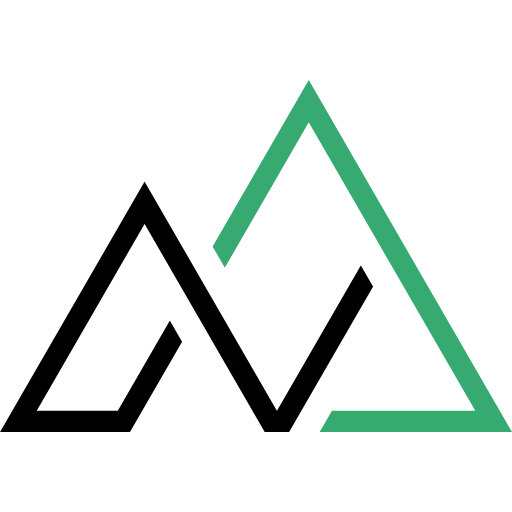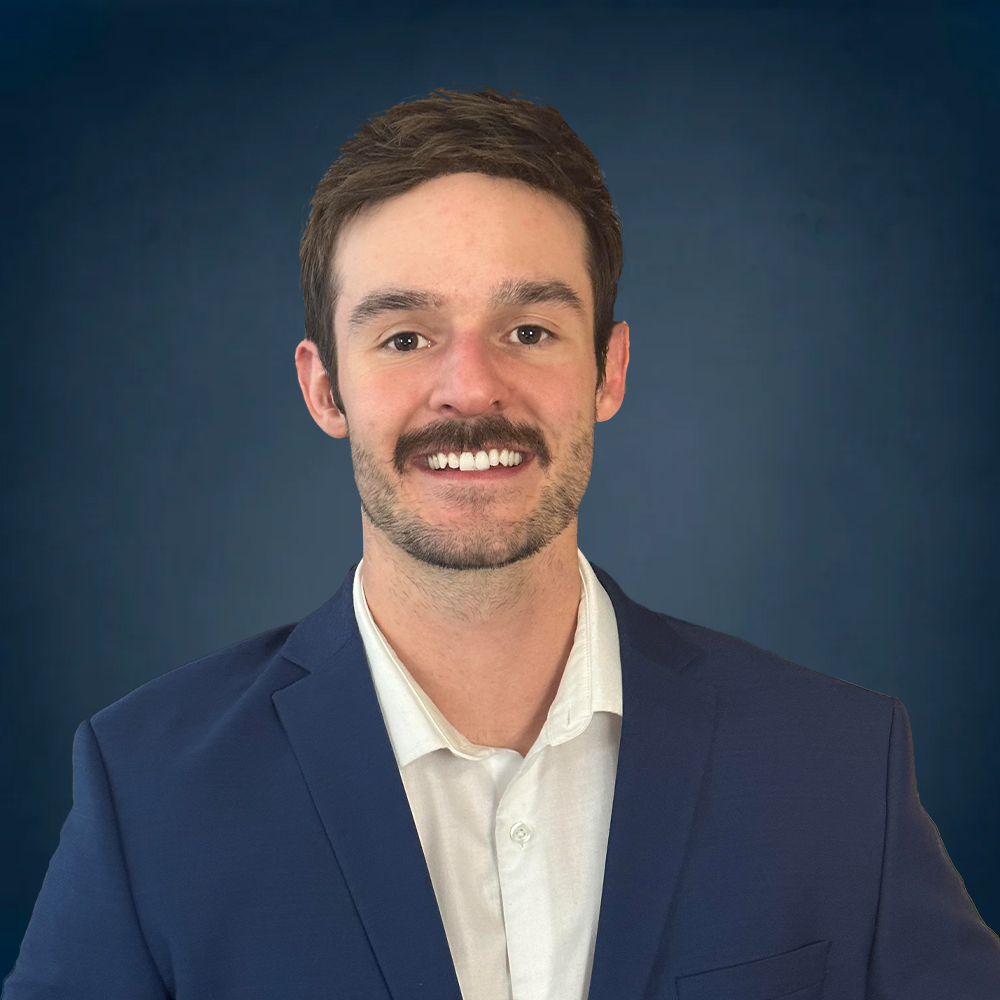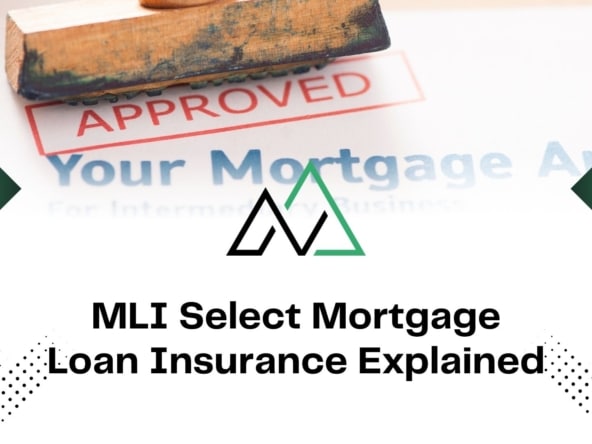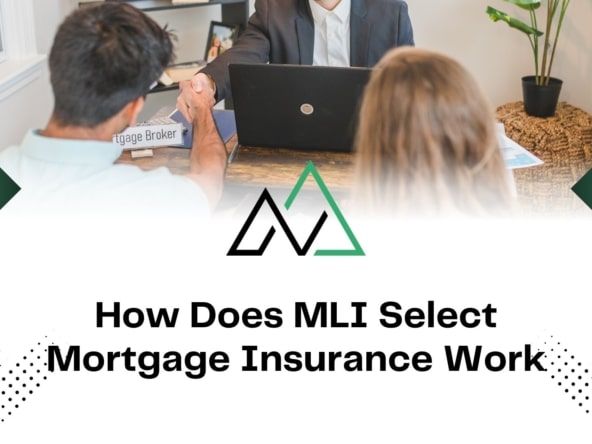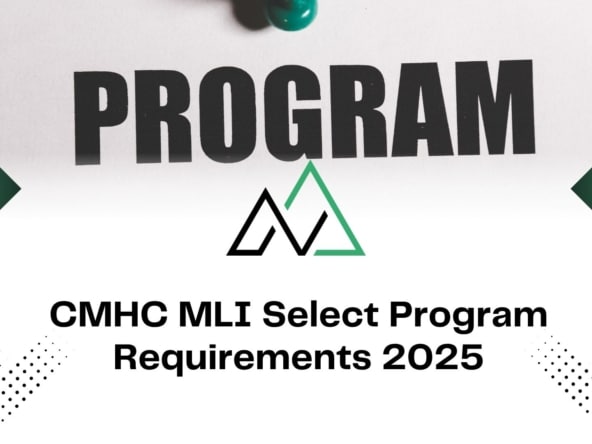Do you dream of owning a home in Canada but can’t save for a down payment? New Homes Alberta gets it. The Canadian real estate market has many ways to buy a house with no money down. These options can make your dream of homeownership come true.
Getting into home financing can be tricky. But, with the right plan and knowledge, it’s possible. Whether you’re starting your career, growing your family, or looking to invest, there are ways to own a property without a big upfront payment.
This guide will show you how to buy a home with little money down. We’ll cover government programs, creative financing, and expert tips. These can make owning a home more achievable for you.
Key Takeaways
- Multiple zero down payment mortgage strategies exist in Canada
- Government programs can help reduce initial home purchase costs
- Creative financing options can supplement traditional down payment methods
- Understanding mortgage insurance requirements is key
- Credit score and income stability are important for mortgage approval
Understanding Zero Down Payment Mortgages in Canada
Exploring the Canadian housing market can be tough, even for first-time buyers. They look into no down payment loans. The mortgage world offers special chances for those with little money upfront.
In Canada, mortgage rules are strict for buying homes. They are tough for those looking at low income or zero-down loans.
Down Payment Landscape
The Canadian mortgage scene has different down payment rules:
- 5% minimum for homes under $500,000
- 5% on first $500,000, 10% on the rest for homes between $500,000-$1 million
- 20% down payment needed for homes over $1 million
Mortgage Insurance Considerations
Zero down mortgages need mortgage insurance. The Canada Mortgage and Housing Corporation (CMHC) requires it for down payments under 20%. The insurance costs can be from 0.60% to 4% of the mortgage amount.
Financing Strategies
There are creative ways to finance a home. Creative solutions like the CMHC FlexDown Program let you borrow down payment money. This opens up new ways to buy a home.
Understanding zero down payment mortgages needs careful research and planning.
Homebuyers should think about their finances, credit score, and future housing plans. This is key when looking at no money down mortgage options.
How to Buy a House With No Money Down
Buying a house with no money down might seem impossible. But, Canadian first-time homebuyer assistance programs offer many ways to own a home. The dream of owning a home doesn’t have to be derailed by limited savings.
Several strategies can help you navigate how to buy a house with no money down:
- Leverage government support programs
- Explore family gifting options
- Utilize personal loan strategies
- Consider alternative financing methods
First-time homebuyers have unique opportunities to minimize upfront costs. The First Time Home Buyer Incentive provides 5% or 10% toward your down payment. This reduces initial financial barriers.
| Financing Option | Down Payment Requirement | Key Benefits |
|---|---|---|
| CMHC Programs | As low as 5% | Government-backed mortgage insurance |
| Family Gift Programs | 0% from personal savings | Full down payment covered by family |
| Personal Line of Credit | Flexible financing | Immediate access to funds |
Credit scores are key in securing zero down payment mortgages. Aim for a credit score of 650 or higher to improve your approval chances. This can lead to more favorable terms.
Homeownership is within reach when you understand the right strategies and leverage available resources.
Understanding these options can transform your home-buying journey. It makes what seems financially impossible suddenly achievable.
Using Personal Lines of Credit for Home Purchase
Looking into different ways to finance a home can help those who want to buy without a down payment. Personal lines of credit and loans are new ways to fund a home. They are great for people who can’t save for a down payment.
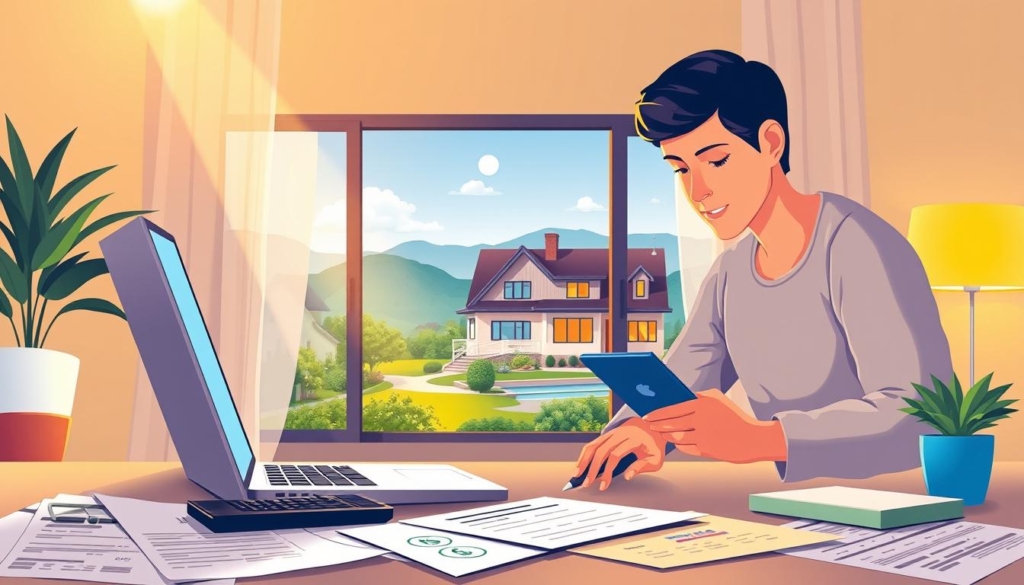
To find no closing cost mortgages, it’s important to know about the financial tools available in Canada. Personal lines of credit are flexible. They can help with down payments in different ways.
Comparing Personal Loans and Credit Lines
When looking at financing options, it’s key to understand the differences between personal loans and credit lines:
- Personal Loans give you a set amount of money to borrow with fixed payments
- Credit Lines let you borrow and repay money as you need it, with flexible terms
- The interest rates depend on your credit score
Impact on Financial Health
Using a loan for a down payment can change your debt-to-income ratio. Lenders look at how this might affect your financial health.
| Financing Option | Typical Interest Rate | Impact on DTI |
|---|---|---|
| Personal Loan | 6.99% – 12.99% | Moderate Increase |
| Home Equity Line of Credit | Prime + 1% (Around 6.85%) | Lower Impact |
Qualification Considerations
To get a zero down payment mortgage with personal credit lines, you need to meet certain requirements:
- Minimum credit score of 650
- Stable income proof
- Good debt service ratios
- Full financial history check
It’s important to plan your finances well and know how much you can borrow for a home purchase.
Leveraging the Home Buyers' Plan (HBP)
The Home Buyers’ Plan (HBP) is a great help for first-time homebuyers. It lets Canadians use their retirement savings to buy a home. This way, they can start their homeownership journey with little cash upfront.
Here’s why the HBP is a good choice for those looking to buy a house with no money down:
- Maximum withdrawal of $60,000 from RRSPs (increased from $35,000)
- Tax-free withdrawal for first-time home purchases
- Interest-free loan with a 15-year repayment period
To qualify for the HBP, you need to:
- Be a first-time homebuyer
- Plan to live in the home as your main residence
- Buy or build a qualifying home before October 1st of the next year after you withdraw
Recent changes to the HBP are great news for homebuyers. Starting April 17, 2024, couples can withdraw up to $120,000 ($60,000 each). Also, for withdrawals from January 1, 2022, to December 31, 2025, the repayment period is longer. This gives buyers more time to pay back.
But, there are things to keep in mind:
- RRSP contributions must stay in the account for at least 90 days before you can withdraw
- Monthly repayments are about $333.33 for a $60,000 withdrawal
- You need to fill out Form T1036 for each withdrawal
Family Support and Love Money Options
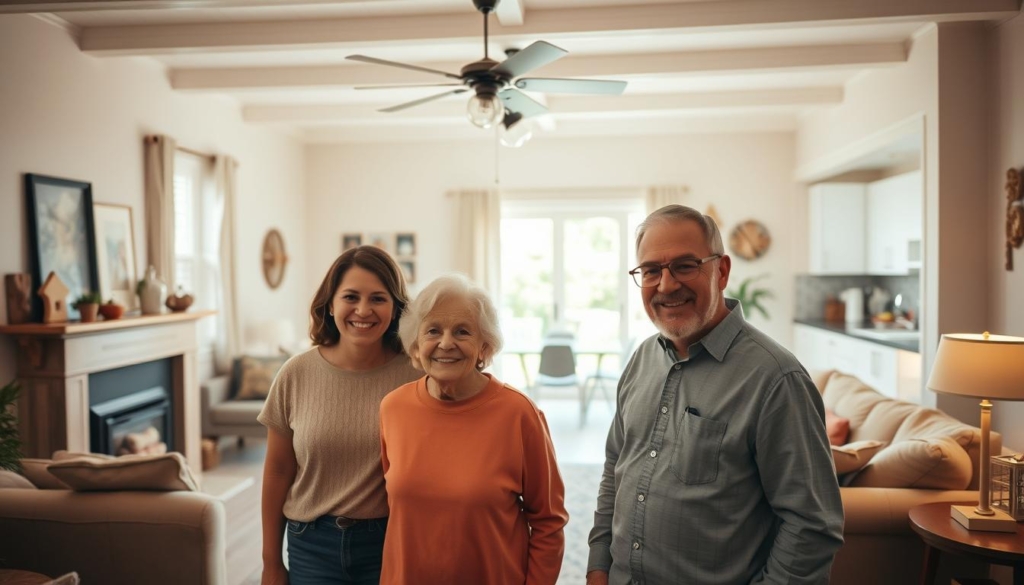
Getting a no down payment home loan can be tough for first-time buyers. Luckily, Canadian families have smart ways to help. Programs for low income buyers and family support can make it easier to start.
Family help comes in many creative ways. It helps buyers get past the usual down payment problems. These methods offer new paths to owning a home, beyond what banks offer.
Gift of Equity Programs
Gift of equity programs are a special help for families. They let relatives sell a property for less than its worth. This creates a down payment for the buyer.
- Property can be sold at reduced price to immediate family
- Difference between market value and sale price becomes the gift
- Potential exemption from property transfer tax
Guarantor Loan Possibilities
Guarantor loans are another smart way to get a home loan. They use a family member’s property equity as collateral. This can lead to better loan terms.
| Loan Type | Key Benefits | Potential Risks |
|---|---|---|
| Guarantor Loan | Lower interest rates | Shared financial responsibility |
| Love Money | Non-refundable gift | Must be interest-free |
Important Note: It’s key to have clear legal papers when family is involved in money deals. This avoids any confusion.
Family support can turn dreams of homeownership into reality for many Canadians.
Co-Buying Strategies for Zero Down Payment
Co-buying is a smart way for Canadians to buy a house without a down payment. It lets people share the cost and enter the housing market together. This makes it easier for first-time buyers to get into the market.
The co-buying trend helps solve many real estate problems. It lets people pool their money to buy better homes. This way, they can overcome the usual down payment hurdles.
- Shared financial responsibility
- Increased mortgage qualification
- Access to better properties
- Reduced individual financial burden
Co-buying is a good option for those wanting to buy a house with no money down. It comes with important things to think about:
| Ownership Type | Key Characteristics |
|---|---|
| Joint Tenancy | Equal ownership shares, right of survivorship |
| Tenancy in Common | Unequal ownership based on financial contributions |
“Co-buying enables first-time homebuyers to transform their homeownership dreams into reality by sharing financial responsibilities.” – Canadian Real Estate Association
For co-buying to work well, you need to:
- Develop a detailed legal agreement
- Set clear financial expectations
- Plan how to exit the arrangement
- Keep financial talks open and honest
Legal protection is key in co-ownership. A real estate lawyer can help make agreements that protect everyone’s interests. They will also outline who owes what financially.
First Home Savings Account (FHSA) Benefits
The First Home Savings Account (FHSA) is a powerful tool for first-time homebuyers. It offers a strategic way to own a home. This savings vehicle gives Canadians financial flexibility when entering the real estate market.
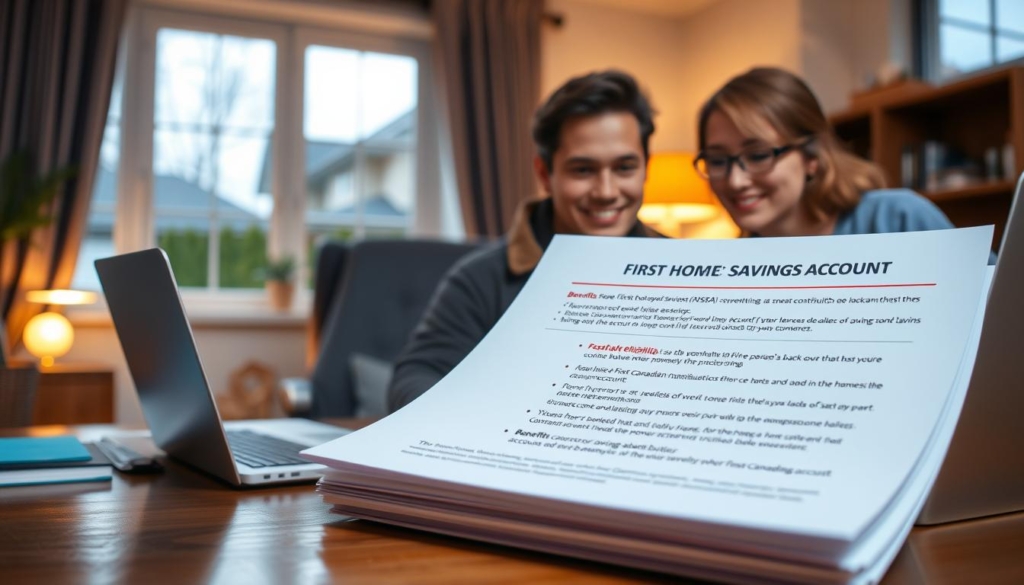
Tax Advantages Explained
Low income home buying programs benefit from the FHSA. It offers great tax benefits for saving for a home:
- Contributions are tax-deductible, reducing your annual tax burden
- Earnings grow tax-free within the account
- Withdrawals for home purchases are completely tax-exempt
Understanding Contribution Limits
The FHSA has clear and generous contribution guidelines. They support first-time homebuyers:
| Contribution Type | Limit |
|---|---|
| Annual Contribution | $8,000 |
| Lifetime Contribution | $40,000 |
| Unused Contribution Carry-Forward | $8,000 |
The FHSA is very appealing for those who want to buy a home. Participants can transfer unused funds to an RRSP or RRIF tax-free if not used for home purchase. The account is open for 15 years or until you turn 71. This gives you plenty of time to plan your home-buying journey.
A smart savings approach can transform your dream of homeownership into reality.
Government Programs for First-Time Buyers
Entering the Canadian housing market can be tough for first-time buyers. But, there are government programs that help. They make owning a home more possible.
The Canadian government has many programs for low-income buyers. These programs offer tax credits, rebates, and financial tools. They help new homeowners with money issues.
- Home Buyers’ Amount Tax Credit: Offers a non-refundable tax credit up to $1,500
- GST/HST New Housing Rebate: Provides rebates on federal tax for new home purchases
- First Home Savings Account (FHSA): Allows tax-free savings up to $40,000
First-time buyers have key financial chances:
| Program | Key Benefit | Maximum Value |
|---|---|---|
| RRSP Home Buyers’ Plan | Tax-free RRSP withdrawal | $60,000 |
| Land Transfer Tax Rebate | Provincial tax relief | Up to $8,000 |
| First-Time Home Buyer Tax Credit | Tax credit for home purchase | $1,500 |
Knowing about these programs can lessen the cost of buying your first home. Each program has its own benefits. They help you reach your dream of owning a home while keeping your finances in check.
Mortgage Loan Insurance Considerations
Understanding zero down payment mortgages means knowing about mortgage loan insurance. This key part helps lenders when buyers put down little money for homes.
In Canada, you need mortgage loan insurance for down payments under 20%. The Canada Mortgage and Housing Corporation (CMHC) is the main provider of this insurance.
Premium Cost Structure
The cost of no closing cost mortgages depends on several factors. Important things to consider include:
- Minimum down payment of 5% for homes under $500,000
- Sliding scale for homes between $500,000 and $1,500,000
- Premium percentages range from 0.60% to 4.00%
Provincial Tax Implications
When looking at zero down payment mortgages, remember the taxes vary by province. Each province has its own rules for mortgage insurance premiums. This affects the total cost of owning a home.
Here’s how premiums are calculated based on loan-to-value ratios:
| Loan-to-Value Ratio | Premium Percentage |
|---|---|
| Up to 65% | 0.60% |
| Up to 75% | 1.70% |
| Up to 80% | 2.40% |
| Up to 95% | 4.00% |
Pro Tip: The CMHC Eco Plus program gives a 25% refund on mortgage insurance for energy-efficient homes. This is a great bonus for buyers who care about the environment.
Alternative Financing Solutions
Exploring the Canadian real estate market can be tough for those with traditional mortgage hurdles. Rent to own homes and other financing options provide new ways to own a home. They help those facing financial challenges.
Canadians have many creative ways to buy a home:
- Lease with option to buy agreements
- Owner financing strategies
- Creative down payment solutions
- Flexible home acquisition methods
Owner financing is a unique choice for homebuyers. It lets sellers lend money directly to buyers. This means buyers can get homes with easier terms.
| Financing Aspect | Details |
|---|---|
| Down Payment | 10-20% of purchase price |
| Interest Rates | 4-10% depending on credit |
| Loan Terms | 5-30 years |
Rent to own homes are another great option. These deals usually last 1-3 years. Renters pay a part of their rent toward a future down payment. This way, they can build equity and get ready for a mortgage.
When looking at alternative financing, it’s important to keep your credit strong. Know the contract terms well. Also, talk to financial experts to avoid risks. With careful thought, owning a home can become a real possibility.
Understanding Total Housing Costs
Buying a house with no money down means you need to know all the costs involved. It’s not just the price of the house. You also have to think about monthly payments and extra expenses that can affect your budget.
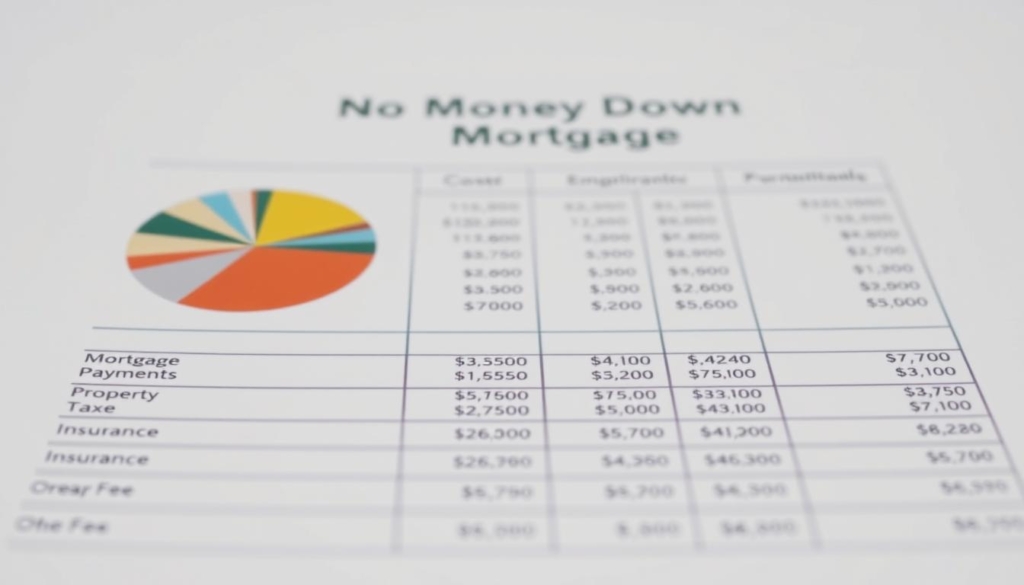
In Canada, homebuyers need to look at several financial factors. This includes no closing cost mortgages and zero down payment options. The Canada Mortgage and Housing Corporation (CMHC) says your monthly housing costs should be no more than 39% of your income.
Monthly Payment Calculations
When figuring out your mortgage payments, remember these important parts:
- Principal and interest payments
- Property taxes
- Heating costs
- Potential mortgage insurance premiums
Additional Expenses to Budget
When you buy a house with no money down, you’ll face extra costs:
- Maintenance Costs: Usually 1% of the home’s value each year
- Home insurance
- Utility expenses
- Potential renovation or repair costs
Experts suggest keeping 3-5% of your home’s value for unexpected costs.
For a $500,000 home, you might face these costs:
| Cost Category | Estimated Percentage | Approximate Amount |
|---|---|---|
| Closing Costs | 2-5% | $10,000-$25,000 |
| Annual Maintenance | 1% | $5,000 |
| Property Taxes | 2-5% | $10,000-$25,000 |
Knowing all the housing costs is key to successful homeownership, even with no money down. Good financial planning is essential for buying a home without a down payment.
Qualifying for a No Down Payment Mortgage
Getting a zero down payment mortgage in Canada needs careful planning and meeting certain financial standards. Unlike regular mortgages that ask for a down payment, some special options let buyers start with little money.
To buy a house with no money down, you must focus on a few important things:
- Exceptional credit score (minimum 650)
- Stable and verifiable income
- Low debt-to-income ratio
- Strong financial history
Credit scores are key for getting a zero down payment mortgage. Lenders want scores over 650, and some private lenders ask for even higher. Keeping your credit clean is very important.
| Qualification Factor | Recommended Threshold |
|---|---|
| Credit Score | 650-700 |
| Income Stability | 2+ years consistent employment |
| Debt-to-Income Ratio | Less than 40% |
Having stable income is also very important. Lenders like to see at least two years of steady work and income. Self-employed people might need to show more proof of their income.
Homebuyers should be ready to share detailed financial info, like tax returns and pay stubs. Working with mortgage experts can make the process easier for zero down payment mortgages.
Working with New Homes Alberta

First-time homebuyers in Alberta face a tough market. New Homes Alberta helps with detailed first-time homebuyer assistance. They show you how to buy a house with no money down.
The company offers special support for those new to homeownership in Alberta. They know the local market well. They help clients understand complex home buying strategies.
- Personalized mortgage application support
- Expertise in no down payment options
- Comprehensive market insights
- Government program navigation
Alberta’s real estate market has great chances for first-time buyers. New Homes Alberta knows the local housing programs well. They help clients get the most out of their purchase.
| Service | Benefits |
|---|---|
| Mortgage Guidance | Streamlined application process |
| Market Research | Informed property selection |
| Program Assistance | Access to first-time buyer programs |
Want to buy a home? Call New Homes Alberta at (403) 305-9167 for a personal consultation. Their experts are ready to make your homeownership dreams come true.
Unlock your path to homeownership with expert local guidance!
Final Thoughts on Buying Your Home in Alberta with No Down Payment
Buying a house with no money down is easier than many think. In Canada, homeowners have many ways to get into the real estate market. This includes government help and creative financing.
To buy a house with no money down, you need a solid financial plan. While zero down payment options are out there, think about the long-term costs. Using the Home Buyers’ Plan, family support, and mortgage insurance can help.
Before buying, get your finances in order. Keep a good credit score, save for closing costs, and know all the costs of buying a home. Some lenders, like HSBC, offer mortgages with just 5% down. Government programs also help new buyers.
Your journey to homeownership is special. Getting advice from mortgage experts and real estate pros can guide you. With the right steps, owning a home in Canada is within reach.
